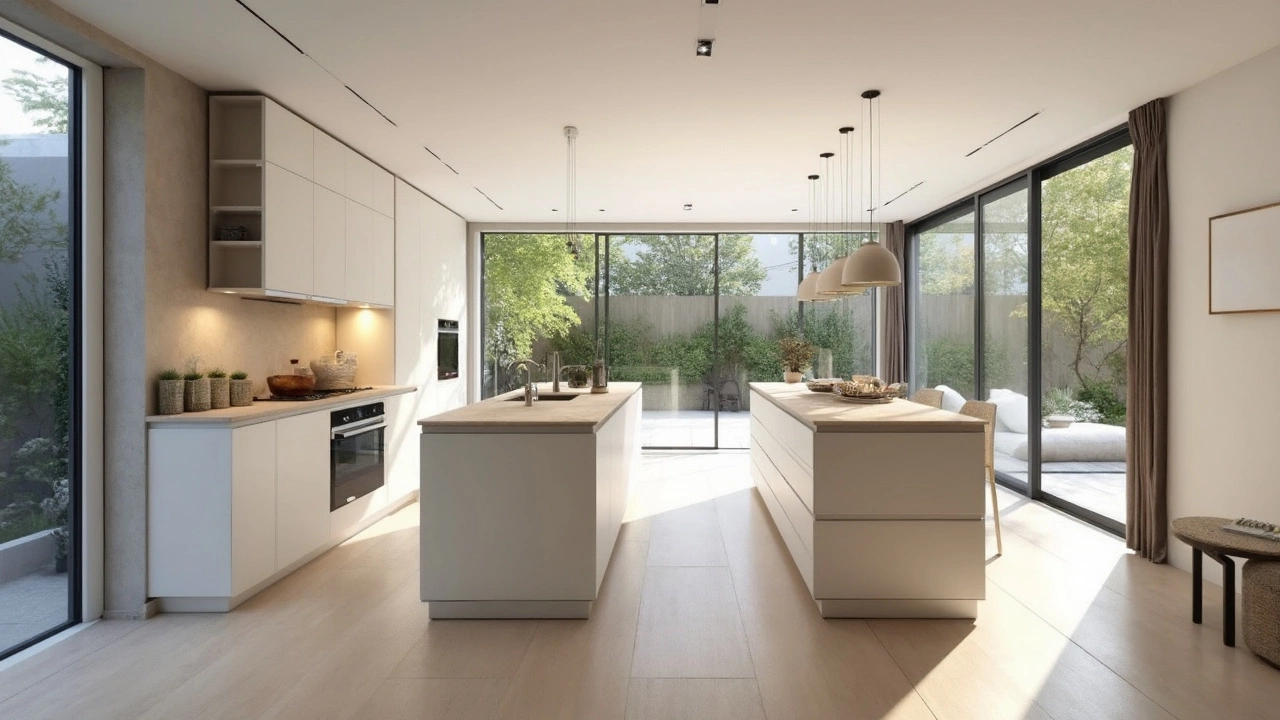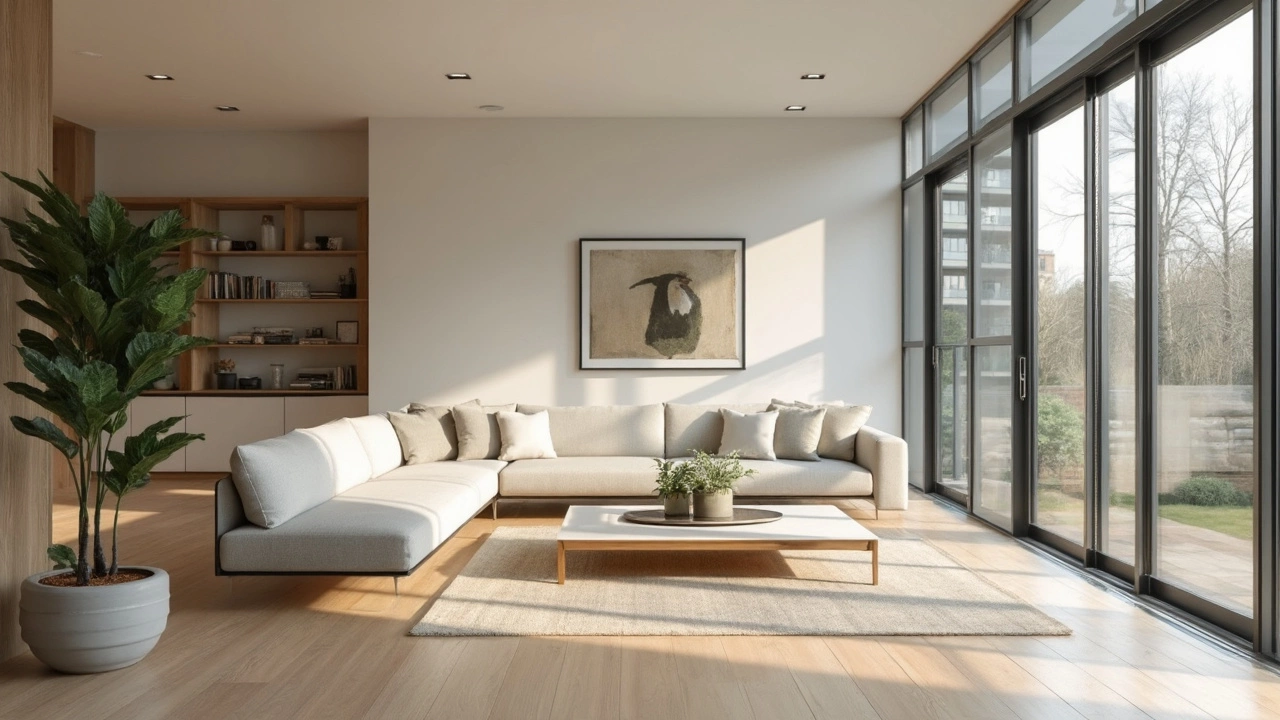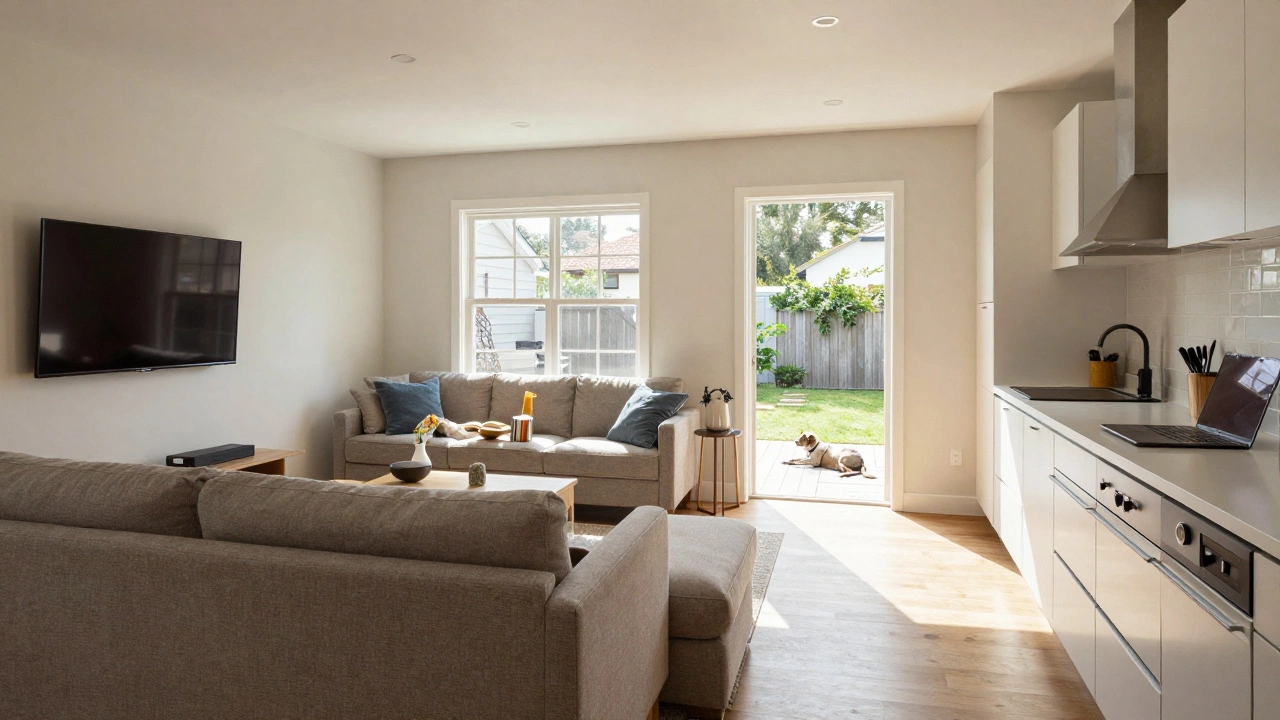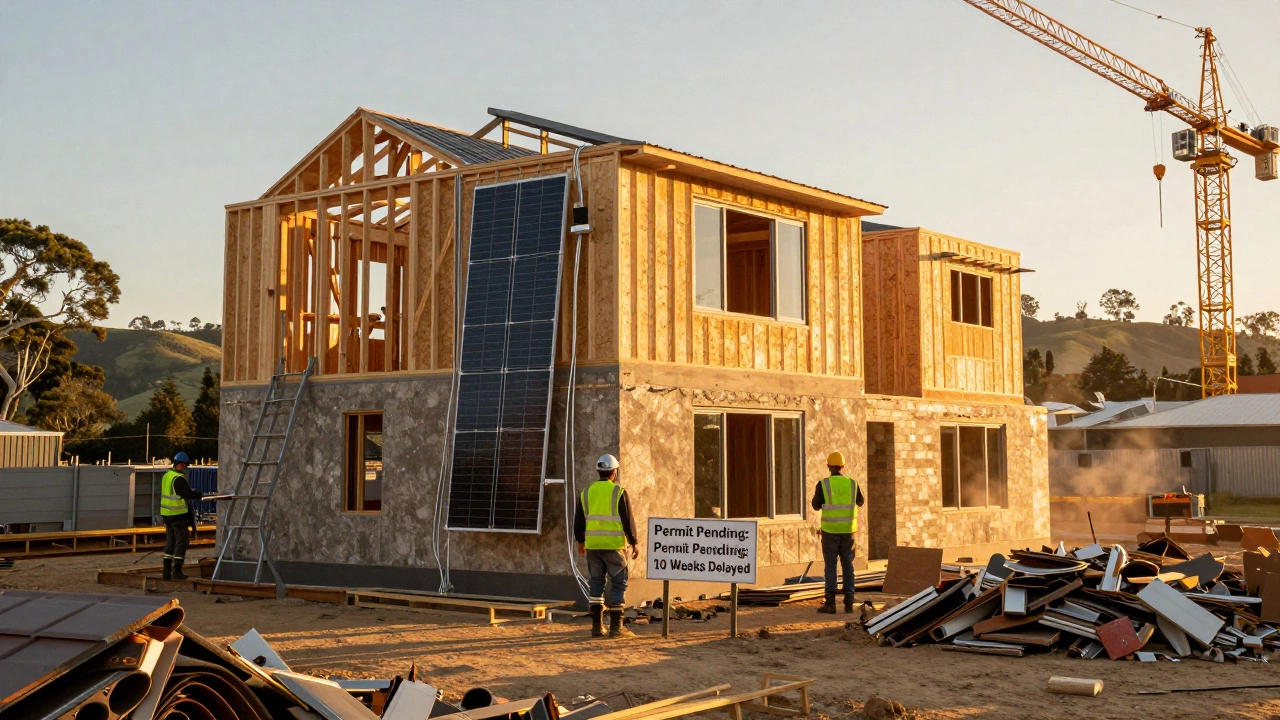Ever notice how so many new homes look almost like art museums? Straight lines, huge windows, barely any clutter—it’s not a coincidence. This design trend actually has a name: modern house style. But here’s the catch—people mix up ‘modern’ and ‘contemporary’ all the time. They aren’t the same, and it’s not just a style invented by one furniture company in Sweden.
Modern house style is super popular right now, especially if you like open spaces, plain surfaces, and rooms that feel bright all day. The style rose to the top in the middle of the 1900s and has roots in much older design movements that wanted to strip away unnecessary ornamentation. Think less is more, but not less comfort or personality.
Wondering if your place could pass for modern? Look for open floor plans, uncluttered spaces, and a lot of natural light. Instead of fancy molding or busy patterns, you'll see smooth wood, glass, and steel. It’s a look that tries hard not to try too hard.
- Modern House Style: What Do We Really Call It?
- Key Features That Define Modern Homes
- Where Did Modern Style Come From?
- Modern vs. Contemporary: Don’t Get Tripped Up
- Common Pitfalls and How to Avoid Them
- Tips to Nail the Modern Look in Your Home
Modern House Style: What Do We Really Call It?
So, what’s the real name for this crisp, open look everyone’s after? It’s usually called “modern” house style, but if we’re being exact, it’s known as “mid-century modern.” This term covers houses built or inspired mostly between the 1940s and 1970s. They’re not just old homes—they’re the blueprint for the modern house style you see everywhere now.
It’s easy to confuse this with “contemporary,” but there’s a big difference. Modern style sticks to ideas from the mid-1900s, while contemporary style changes with trends. If you want those classic clean lines and open spaces, you’re after modern, not whatever’s trending this year.
According to the National Association of Home Builders, "Modern residential design is defined by simplicity, natural materials, and a strong connection to the outdoors. Large glass panels, open floor plans, and minimal ornamentation are key features."
"A truly modern home isn’t about showing off. It’s about improving day-to-day living by making things more functional and beautiful at the same time." — National Association of Home Builders
It also goes by a few other names—like International Style or Bauhaus—especially in architecture textbooks. In the real world, though, most people just say "modern" or "mid-century modern." Walk through neighborhoods built post-World War II, and you’ll see this everywhere: flat or low-pitched roofs, wide eaves, and huge windows that bring the outdoors in. This is the style that’s inspired loads of today’s home renovation shows and furniture stores.
If you spot a home with open rooms, big panes of glass, and almost no fluff or decoration, you can safely call it modern. But don’t forget: modern is a spirit, not just a checklist. It’s about easy living, clear lines, and a focus on light and air.
Key Features That Define Modern Homes
If you want to spot a modern house style, keep an eye out for a few dead giveaways. Modern homes break from traditions—no fancy carvings, no unnecessary trimmings, and definitely no over-the-top paint jobs. Here’s what actually sets them apart:
- Open Floor Plans: Spaces flow into each other. Kitchens blend into living rooms. Hallways keep a low profile—or disappear entirely.
- Big Windows: Modern homes love natural light, so you’ll see lots of floor-to-ceiling glass that brings the outside in.
- Minimalism: If you can ditch a decoration, do it. Counters, walls, and even shelves stay pretty bare. The look is more about how things feel than how much stuff is on display.
- Industrial Materials: Steel, exposed concrete, flat panel cabinets, and smooth wood are the stars. These finishes show up in kitchens, bathrooms, and even living rooms.
- Neutral Colors: Think lots of white, grays, blacks, and wood tones. Pops of color are rare and meant to stand out.
"Modern architecture is all about clarity and openness," says Le Corbusier, a pioneer of modern design. "A house is a machine for living in."
One cool thing to know: starting in the 1950s, U.S. suburbs exploded with single-story, flat-roof homes using this exact playbook. That’s the classic mid-century modern style that people are still obsessed with today.
If you like real data, check this out. Here’s how some of the most common elements show up in new builds:
| Feature | % of New Homes (2023-2024) |
|---|---|
| Open Floor Plan | 82% |
| Large Windows | 78% |
| Minimalist Cabinets & Fixtures | 69% |
| Neutral Color Schemes | 74% |
Designers boost these numbers every season, because buyers want homes that feel both fresh and timeless. If you’re aiming for a true modern look, skip heavy curtains, patterned wallpaper, and fussy hardware—opt for clean, unfussy finishes and let the layout do the talking.
Where Did Modern Style Come From?
Modern house style didn't just happen out of nowhere. It goes all the way back to the early 1900s when architects and designers wanted buildings and houses to feel simple and practical, not fussy like old Victorian homes. The Bauhaus movement in Germany was a big deal here—those folks believed form should follow function, meaning your house should work for you, not just look pretty. This mindset crossed over to the United States fast.
After World War II, people wanted affordable, quick-to-build homes. This led to the rise of mid-century modern houses. You’ve probably seen those ranch homes with flat roofs, open plans, and big glass sliding doors. Architects like Frank Lloyd Wright and Ludwig Mies van der Rohe really set the stage, focusing on open flow and a strong connection between indoors and outdoors.
Let’s look at some movements and names you might've heard, plus when they became popular:
| Movement/Architect | Country | Years Active | Key Idea |
|---|---|---|---|
| Bauhaus | Germany | 1919–1933 | Simple shapes, less decoration |
| Frank Lloyd Wright | USA | 1890s–1950s | Blending homes with nature |
| Mid-century Modern | USA | 1945–1970 | Open plans, natural light |
| Ludwig Mies van der Rohe | Germany/USA | 1920s–1960s | "Less is more" idea |
One thing to remember: modern house style isn’t about cold spaces or just saving money. The real goal was to get rid of stuff you don’t need, connect with your environment, and create homes that actually make sense for the way regular people live. That’s why it’s still so popular, decades later. The clean look and practical layout speak to what people actually want from their homes today.

Modern vs. Contemporary: Don’t Get Tripped Up
It’s easy to mix up “modern” and “contemporary” when talking about home design, but they’re not twins—more like distant cousins. Modern houses have a look that comes straight from the early to mid-1900s, especially the famous mid-century modern movement. So if you see low-slung furniture, simple shapes, and a big focus on letting the outside in, you’re looking at modern style. On the other hand, contemporary homes are all about what’s hot right now. The vibe keeps changing every decade.
One of the top mistakes people make is calling every cool, uncluttered home “modern.” Not all of them are. Even realtors get tripped up. According to a 2023 design trend report, nearly 42% of home listings use “modern” and “contemporary” almost interchangeably, but only a fraction actually match true modern characteristics.
"True modern design has roots in the past, grounded in function and simplicity, while contemporary style simply means what’s trending at the moment." — Emily Henderson, Interior Designer
If you want to spot the difference, keep an eye out for these traits:
- Modern house style (from 1920s–1970s): Flat or low-pitched roofs, open floor plans, bold rectangles, natural materials, industrial touches like steel or concrete.
- Contemporary style (from 1980s to today): Lots of experimenting, curved lines, eco-friendly tech, smart home features, whatever’s currently trending in materials and color schemes.
Here’s a side-by-side comparison to make it super clear:
| Feature | Modern | Contemporary |
|---|---|---|
| Main era | 1920s–1970s | Current decade |
| Materials | Wood, steel, glass | Mixed – even recycled plastics |
| Feel | Warm, functional | Experimental, evolving |
| Color palette | Neutrals, earth tones | Any – often bold or unpredictable |
If you want to keep your home looking sharp and up-to-date, lean into contemporary touches. If you’re in love with that mid-century look, stick with real modern details, because they never seem to go out of style.
Common Pitfalls and How to Avoid Them
Thinking you're pulling off the modern house style when you're actually missing the mark is way too common. It's easy to get excited by a Pinterest board, then end up with a space that feels cold, awkward, or cluttered—even if your square footage is huge. Here are the big mistakes people make and how you can sidestep them.
- Going Too Cold and Sterile: People sometimes believe modern means empty white rooms with nothing but hard surfaces. Truth is, real modern homes still feel inviting. Use texture (like rugs or woven baskets) and add plants or warm wood tones to balance things out.
- Mixing Up Modern and Contemporary: Modern refers to mid-century design from roughly the 1920s to the 1970s. Contemporary is what’s popular now and changes often. Don’t mix styles or you lose that cohesive look.
- Clutter Creep: Clutter slips in fast. Modern houses only work when you’re honest about what stays and what goes. Make sure every piece has a purpose—and ditch what isn’t useful or beautiful.
- Ignoring Lighting: Many people focus on natural light but forget layered lighting. You need a mix: overhead fixtures, floor lamps, and subtle task lights keep your home from feeling like a hospital waiting room at night.
- Cheap Materials: Modern style often uses glass, steel, and wood but poor-quality imitations stand out. Splurge on fewer, better pieces instead of filling the place with low-cost knockoffs.
Check out how often these mistakes come up, based on feedback from interior designers and builders:
| Pitfall | % of Projects With This Mistake (2024) |
|---|---|
| Too much white/no warmth | 47% |
| Mixing modern with other styles | 34% |
| Cluttered surfaces | 41% |
| Poor lighting choices | 29% |
| Cheap materials | 38% |
So how do you avoid these headaches?
- Layer your lighting—think pendant lights, floor lamps, and maybe smart bulbs.
- Choose real materials over imitations when you can. If you save up for just one real wood table, it’ll pay off.
- Keep surfaces simple. A bowl of fruit is okay; a whole shelf of knickknacks, not so much.
- Add soft elements so your rooms don’t just look modern—they feel good too.
Basically, the modern house style isn’t about showing off your stuff—it’s about keeping what matters and letting your home breathe.
Tips to Nail the Modern Look in Your Home
Nailing that real modern house style vibe isn’t about buying all new furniture or going full trendy. It’s really about a handful of smart moves that change how your place feels and works.
- Embrace Open Spaces: Knock down that extra wall if you can, or just rearrange your living room to give everything breathing room. Modern houses love open layouts—less division, more interaction.
- Keep It Simple: Modern design never tries to impress by being fussy. Go for clean lines, plain colors, and shapes that look easy on the eyes. Think furniture with low profiles and no extra frills.
- Use Natural Light: Those big windows aren’t just for show. Skip heavy curtains if you can and let sunlight fill your rooms. If privacy matters, go for sheer fabrics that let light in but block peeping eyes.
- Add the Right Materials: Wood, metal, glass, and concrete work best. Try a glass coffee table, a metal light fixture, or wooden shelves. Even a little concrete—maybe as a planter or lamp base—adds the right touch.
- Edit Your Stuff: Modern homes are almost allergic to clutter. Be ruthless with what stays out on display. The famous "one in, one out" rule really works: bring something in, let something go.
- Befriend Neutral Colors: Stick to gray, white, black, taupe, and a few pops of color if you want. Let textures stand out instead of bold prints. Layer with different fabrics like linen and leather for interest.
- Mix in Iconic Pieces: If you want to get serious, hunt down a few classic mid-century modern furniture items. Think Eames chairs, or even a knockoff if your budget’s tight. Just one or two will set the tone.
Small changes add up. Swapping busy rugs for a plain one, or switching out old cabinet handles for simple metal pulls, can make all the difference. The main goal? Make your place feel uncluttered, honest, and full of light. You’ll know the look is right when things feel calm and you want to kick off your shoes the second you get home.






